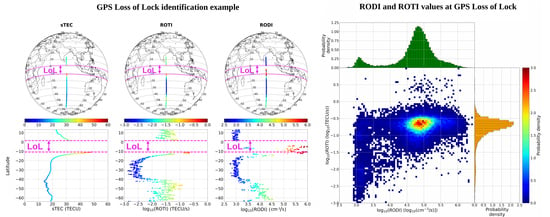Occurrence of GPS Loss of Lock Based on a Swarm Half-Solar Cycle Dataset and Its Relation to the Background Ionosphere
Abstract
1. Introduction
2. Data and Methods
2.1. Swarm Data
2.2. Ionospheric Indices: RODI and ROTI
2.2.1. RODI
2.2.2. ROTI
2.3. GPS Loss of Lock Identification Methodology
- sTEC time series of each specific GPS satellite (then, of each specific PRN) are extracted from the L2 TEC data files (which contain data of all the 32 GPS satellites);
- From the sTEC time series of each specific PRN, we identify the segments of orbit for which the GPS satellite is in the field of view;
- For each of these segments of orbit, interruptions in the sTEC time series ranging from 1 to 1200 s are identified. The choice of this range guarantees that the identified interruptions are actually LoL and not due to the fact that the satellite has gone out of the field of view. This means that if, for instance, a LoL begins just before the satellite is going outside the POD field of view, this event will not be considered in our dataset;
- Steps 1–3 loop for each of the 32 GPS satellites (then, for each PRN).
3. Results and Discussion
3.1. Loss of Lock Occurrence Distribution
3.2. RODI and ROTI Values at GPS Loss of Lock
4. Summary and Conclusions
- LoL events are mainly located at low and high latitudes, for both hemispheres. Specifically, at low latitudes they maximize along the EIA crests between about 70° W and 10° E of longitude;
- The high-latitude LoL occurrence is higher in the Southern hemisphere than in the Northern hemisphere. Is this asymmetry real? This is a point that needs further analyses;
- At low latitudes, LoL events cluster around equinoxes; both high and low latitudes are characterized by a minimum of occurrence in June, July, and August, independently of the season. This non-seasonality of the LoL occurrence is intriguing and deserves additional analyses;
- At low latitudes, LoL events cluster between 19 and 23 MLT, while at high latitudes the diurnal distribution of LoL is more uniform, with maxima characterizing the local noon and the nighttime sector between 18 and 00 MLT;
- LoL events strongly depend on solar activity, maximizing for years of maximum solar activity and reducing significantly for years of minimum solar activity;
- LoL events are strictly connected with very high values of both RODI and ROTI, meaning that they are most likely to occur inside regions characterized by very large electron density gradients;
- Joint probability density distributions between RODI and ROTI values corresponding to LoL events showed that there is a well-defined family for which LoL events tend to cluster. Moreover, in terms of RODI, the values are somewhat consistent with those recently found by studies focused on the turbulent feature of ionospheric irregularities, which suggests that LoL events are likely caused by irregularities triggered by processes of turbulent nature. The position of this family changes moving from high to low latitudes. Does this movement imply that the physical processes responsible for the ionospheric irregularities formation at the base of LoL events are different? Moreover, is the second family visible for lower values of RODI (around 3) real? These questions deserve additional analyses.
Supplementary Materials
Author Contributions
Funding
Data Availability Statement
Acknowledgments
Conflicts of Interest
Acronyms
| EIA | equatorial ionospheric anomaly |
| EPB | equatorial plasma bubble |
| ESA | European Space Agency |
| GNSS | Global Navigation Satellite System |
| GPS | Global Positioning System |
| IPP | Ionospheric Pierce Point |
| L2 | Level 2 |
| LoL | loss of lock |
| LP | Langmuir Probe |
| MLT | Magnetic Local Time |
| NH | Northern hemisphere |
| POD | Precise Orbit Determination |
| PRE | pre-reversal enhancement |
| PRN | Pseudo Random Noise |
| QD | Quasi-Dipole |
| ROD | rate of change of electron density |
| RODI | rate of change of electron density index |
| ROT | rate of change of TEC |
| ROTI | rate of change of TEC index |
| RT | Rayleigh-Taylor |
| SH | Southern hemisphere |
| sTEC | slant TEC |
| TEC | total electron content |
| vTEC | vertical TEC |
References
- Yeh, K.C.; Liu, C.H. Radio wave scintillations in the ionosphere. Proc. Inst. Electr. Eng. 1982, 70, 324–360. [Google Scholar] [CrossRef]
- Cerruti, A.P.; Kintner, P.M.; Gary, D.E.; Mannucci, A.J.; Meyer, R.F.; Doherty, P.; Coster, A.J. Effect of intense December 2006 solar radio bursts on GPS receivers. Space Weather 2008, 6, S10D07. [Google Scholar] [CrossRef]
- Alfonsi, L.; Spogli, L.; Pezzopane, M.; Romano, V.; Zuccheretti, E.; De Franceschi, G.; Cabrera, M.A.; Ezquer, R.G. Comparative analysis of spread-F signature and GPS scintillation occurrences at Tucuman, Argentina. J. Geophys. Res. Space Phys. 2013, 118, 4483–4502. [Google Scholar] [CrossRef]
- Béniguel, Y. Ionospheric scintillations: Indices and modeling. Radio Sci. 2019, 54, 618–632. [Google Scholar] [CrossRef]
- Yizengaw, E.; Groves, K. Forcing from lower thermosphere and quiet time scintillation longitudinal dependence. Space Weather 2020, 18, e2020SW002610. [Google Scholar] [CrossRef]
- Buchert, S.; Zangerl, F.; Sust, M.; André, M.; Eriksson, A.; Wahlund, J.-E.; Opgenoorth, H. Swarm observations of equatorial electron densities and topside GPS track losses. Geophys. Res. Lett. 2015, 42, 2088–2092. [Google Scholar] [CrossRef]
- Yue, X.; Schreiner, W.S.; Pedatella, N.M.; Kuo, Y.-H. Characterizing GPS radio occultation loss of lock due to ionospheric weather. Space Weather 2016, 14, 285–299. [Google Scholar] [CrossRef]
- Liu, Y.; Fu, L.; Wang, J.; Zhang, C. Study of GNSS loss of lock characteristics under ionosphere scintillation with GNSS data at Weipa (Australia) during solar maximum phase. Sensors 2017, 17, 2205. [Google Scholar] [CrossRef]
- Jin, Y.; Oksavik, K. GPS scintillations and losses of signal lock at high latitudes during the 2015 St. Patrick’s Day storm. J. Geophys. Res. 2018, 123, 7943–7957. [Google Scholar] [CrossRef]
- Piersanti, M.; De Michelis, P.; Del Moro, D.; Tozzi, R.; Pezzopane, M.; Consolini, G.; Marcucci, M.F.; Laurenza, M.; Di Matteo, S.; Pignalberi, A.; et al. From the Sun to Earth: Effects of the 25 August 2018 geomagnetic storm. Ann. Geophys. 2020, 38, 703–724. [Google Scholar] [CrossRef]
- Damaceno, J.G.; Bolmgren, K.; Bruno, j.; De Franceschi, G.; Mitchell, C.; Cafaro, M. GPS loss of lock statistics over Brazil during the 24th solar cycle. Adv. Space Res. 2020, 66, 219–225. [Google Scholar] [CrossRef]
- Zhang, S.; He, L.; Wu, L. Statistical study of loss of GPS signals caused by severe and great geomagnetic storms. J. Geophys. Res. Space Phys. 2020, 125, e2019JA027749. [Google Scholar] [CrossRef]
- Xiong, C.; Stolle, C.; Lühr, H. The Swarm satellite loss of GPS signal and its relation to ionospheric plasma irregularities. Space Weather 2016, 14, 563–577. [Google Scholar] [CrossRef]
- Xiong, C.; Stolle, C.; Park, J. Climatology of GPS signal loss observed by Swarm satellites. Ann. Geophys. 2018, 36, 679–693. [Google Scholar] [CrossRef]
- Friis-Christensen, E.; Lühr, H.; Hulot, G. Swarm: A constellation to study the Earth’s magnetic field. Earth Planets Space 2006, 58, 351–358. [Google Scholar] [CrossRef]
- Knudsen, D.J.; Burchill, J.K.; Buchert, S.C.; Eriksson, A.I.; Gill, R.; Wahlund, J.-E.; Åhlen, L.; Smith, M.; Moffat, B. Thermal ion imagers and Langmuir probes in the Swarm electric field instruments. J. Geophys. Res. Space Phys. 2017, 122, 2655–2673. [Google Scholar] [CrossRef]
- Van den IJssel, J.; Forte, B.; Montenbruck, O. Impact of Swarm GPS receiver updates on POD performance. Earth Planets Space 2016, 68, 85. [Google Scholar] [CrossRef]
- Swarm L1b Product Definition. Available online: https://earth.esa.int/documents/10174/1514862/Swarm_L1b_Product_Definition (accessed on 31 May 2021).
- Lomidze, L.; Knudsen, D.J.; Burchill, J.; Kouznetsov, A.; Buchert, S.C. Calibration and validation of Swarm plasma densities and electron temperatures using ground-based radars and satellite radio occultation measurements. Radio Sci. 2018, 53, 15–36. [Google Scholar] [CrossRef]
- Swarm L2 TEC Product Description. Available online: https://earth.esa.int/eogateway/documents/20142/37627/swarm-level-2-tec-product-description.pdf/8fe7fa04-6b4f-86a7-5e4c-99bb280ccc7e (accessed on 31 May 2021).
- Noja, M.; Stolle, C.; Park, J.; Luhr, H. Long-term analysis of ionospheric polar patches based on CHAMP TEC data. Radio Sci. 2013, 48, 289–301. [Google Scholar] [CrossRef]
- Jin, Y.; Spicher, A.; Xiong, C.; Clausen, L.B.N.; Kervalishvili, G.; Stolle, C.; Miloch, W.J. Ionospheric plasma irregularities characterized by the Swarm satellites: Statistics at high latitudes. J. Geophys. Res. Space Phys. 2019, 124, 1262–1282. [Google Scholar] [CrossRef]
- De Michelis, P.; Pignalberi, A.; Consolini, G.; Coco, I.; Tozzi, R.; Pezzopane, M.; Giannattasio, F.; Balasis, G. On the 2015 St. Patrick Storm Turbulent State of the Ionosphere: Hints from the Swarm Mission. J. Geophys. Res. Space Phys. 2020, 125, e2020JA027934. [Google Scholar] [CrossRef]
- De Michelis, P.; Consolini, G.; Tozzi, R.; Pignalberi, A.; Pezzopane, M.; Coco, I.; Giannattasio, F.; Marcucci, M.F. Ionospheric Turbulence and the Equatorial Plasma Density Irregularities: Scaling Features and RODI. Remote Sens. 2021, 13, 759. [Google Scholar] [CrossRef]
- Zakharenkova, I.; Astafyeva, E.; Cherniak, I. GPS and in situ Swarm observations of the equatorial plasma density irregularities in the topside ionosphere. Earth Planets Space 2016, 68, 120. [Google Scholar] [CrossRef]
- Zakharenkova, I.; Astafyeva, E. Topside ionospheric irregularities as seen from multisatellite observations. J. Geophys. Res. Space Phys. 2015, 120, 807–824. [Google Scholar] [CrossRef]
- Pignalberi, A. TITIPy: A Python tool for the calculation and mapping of topside ionosphere turbulence indices. Comp. Geosc. 2021, 148, 104675. [Google Scholar] [CrossRef]
- Pi, X.; Mannucci, A.J.; Lindqwister, U.J.; Ho, C.M. Monitoring of global ionospheric irregularities using the worldwide GPS network. Geophys. Res. Lett. 1997, 24, 2283. [Google Scholar] [CrossRef]
- De Rezende, L.F.C.; De Paula, E.R.; Kantor, I.J. Mapping and survey of plasma bubbles over Brazilian territory. J. Navig. 2007, 60, 69–81. [Google Scholar] [CrossRef]
- Amabayo, E.B.; Jurua, E.; Cilliers, P.J.; Habarulema, J.B. Climatology of ionospheric scintillations and TEC trend over the Ugandan region. Adv. Space Res. 2014, 53, 734–743. [Google Scholar] [CrossRef]
- Mungufeni, P.; Jurua, E.; Habarulema, J.B.; Anguma, S.K. Modelling the probability of ionospheric irregularity occurrence over African low latitude region. J. Atmos. Sol. Terr. Phys. 2015, 128, 46–57. [Google Scholar] [CrossRef]
- Oladipo, E.A.; Xurxo, O.V.; Claudia, P.; Rodrigue, H.N.; Radicella, S.M.; Nava, B. Signature of ionospheric irregularities under different geophysical conditions on SBAS performance in the western African low-latitude region. Ann. Geophys. 2017, 35, 1–9. [Google Scholar] [CrossRef]
- Paznukhov, V.V.; Carrano, C.S.; Doherty, P.H.; Groves, K.M.; Caton, R.G.; Valladares, C.E.; Seemala, G.K.; Bridgwood, C.T.; Adeniyi, J.; Amaeshi, L.L.N.; et al. Equatorial plasma bubbles and L-band scintillations in Africa during solar minimum. Ann. Geophys. 2012, 30, 675–682. [Google Scholar] [CrossRef]
- Magdaleno, S.; Miguel, H.; Altadill, D.; Benito, A. Climatology characterization of equatorial plasma bubbles using GPS data. J. Space Weather Space Clim. 2017, 7, A3. [Google Scholar] [CrossRef]
- Stolle, C.; Luhr, H.; Rother, M.; Balasis, G. Magnetic signatures of equatorial spread F as observed by the CHAMP satellite. J. Geophys. Res. 2006, 111, A02304. [Google Scholar] [CrossRef]
- Burke, W.J.; Gentile, L.C.; Huang, C.Y.; Valladares, C.E.; Su, S.Y. Longitudinal variability of equatorial plasma bubbles observed by DMSP and ROCSAT-1. J. Geophys. Res. 2004, 109, A12301. [Google Scholar] [CrossRef]
- Tsunoda, R.T. Control of the seasonal and longitudinal occurrence of equatorial scintillations by the longitudinal gradient in the integrated E-region Pedersen conductivity. J. Geophys. Res. 1985, 90, 447. [Google Scholar] [CrossRef]
- Abdu, M.A.; Iyer, K.N.; de Mederios, R.T.; Batista, I.S.; Sobral, J.H.A. Thermospheric meridional wind control of equatorial spread-F and evening prereversal electric field. Geophys. Res. Lett. 2006, 33, L07106. [Google Scholar] [CrossRef]
- Saito, S.; Maruyama, T. Ionospheric height variations observed by ionosondes along magnetic meridian and plasma bubble onsets. Ann. Geophys. 2006, 24, 2991–2996. [Google Scholar] [CrossRef]
- Huang, C.-S.; Kelley, M.C. Nonlinear evolution of equatorial spread F: 2. Gravity wave seeding of Rayleigh-Taylor instability. J. Geophys. Res. 1996, 101, 293–302. [Google Scholar] [CrossRef]
- McClure, J.P.; Singh, S.; Bamgboye, D.K.; Johnson, F.S.; Kil, H. Occurrence of equatorial F region irregularities: Evidence for tropospheric seeding. J. Geophys. Res. 1998, 103, 29119–29135. [Google Scholar] [CrossRef]
- Huang, C.Y.; Burke, W.J.; Machuzak, J.S.; Gentile, L.C.; Sultan, P.J. DMSP observations of equatorial plasma bubbles in the topside ionosphere near solar maximum. J. Geophys. Res. 2001, 106, 8131. [Google Scholar] [CrossRef]
- Tsunoda, R.T. High-latitude F-region irregularities: A review and synthesis. Rev. Geophys. 1988, 26, 719–760. [Google Scholar] [CrossRef]
- Basu, S.; Mackenzie, E.; Coley, W.R.; Sharber, J.R.; Hoegy, W.R. Plasma structuring by the gradient drift instability at high-latitudes and comparison with velocity shear driven processes. J. Geophys. Res. 1990, 95, 7799–7818. [Google Scholar] [CrossRef]
- Carlson, H. C The dark polar ionosphere: Progress and future challenges. Radio Sci. 1994, 29, 157–165. [Google Scholar] [CrossRef]
- Clausen, L.B.N.; Moen, J.I.; Hosokawa, K.; Holmes, J.M. GPS scintillations in the high latitudes during periods of dayside and nightside reconnection. J. Geophys. Res. Space Phys. 2016, 121, 3293–3309. [Google Scholar] [CrossRef]
- Kelley, M.C.; Vickrey, J.F.; Carlson, C.W.; Torbert, R. On the origin and spatial extent of high-latitude F region irregularities. J. Geophys. Res. 1982, 87, 4469–4475. [Google Scholar] [CrossRef]
- Cherniak, I.; Zakharenkova, I.; Redmon, R.J. Dynamics of the high-latitude ionospheric irregularities during the 17 March 2015 St. Patrick’s Day storm: Ground-based GPS measurements. Space Weather 2015, 13, 585–597. [Google Scholar] [CrossRef]
- Cherniak, I.; Zakharenkova, I. High-latitude ionospheric irregularities: Differences between ground-and space-based GPS measurements during the 2015 St. Patrick’s Day storm. Earth Planets Space 2016, 68, 136. [Google Scholar] [CrossRef]
- Bjoland, L.M.; Ogawa, Y.; Løvhaug, U.P.; Lorentzen, D.A.; Hatch, S.M.; Oksavik, K. Electron density depletion region observed in the polar cap ionosphere. J. Geophys. Res. Space Phys. 2021, 126, e2020JA028432. [Google Scholar] [CrossRef]
- Laundal, K.M.; Richmond, A.D. Magnetic Coordinate Systems. Space Sci. Rev. 2017, 206, 27. [Google Scholar] [CrossRef]
- Mendillo, M.; Huang, C.-L.; Pi, X.; Rishbeth, H.; Meier, R. The global ionospheric asymmetry in total electron content. J. Atmos. Sol. Terr. Phys. 2005, 67, 1377–1387. [Google Scholar] [CrossRef]
- Abiriga, F.; Amabayo, E.B.; Jurua, E.; Cilliers, P.J. Statistical characterization of equatorial plasma bubbles over East Africa. J. Atmos. Sol. Terr. Phys. 2020, 200, 105197. [Google Scholar] [CrossRef]
- Fejer, B.G.; Scherliess, L.; de Paula, E.R. Effects of the vertical plasma drift velocity on the generation and evolution of equatorial spread F. J. Geophys. Res. 1999, 104, 19859–19869. [Google Scholar] [CrossRef]
- Scherliess, L.; Fejer, B.G. Radar and satellite global equatorial F region vertical drift model. J. Geophys. Res. 1999, 104, 6829. [Google Scholar] [CrossRef]
- Cai, X.; Burns, A.G.; Wang, W.; Qian, L.; Liu, J.; Solomon, S.C.; Eastes, R.W.; Daniell, R.E.; Martinis, C.R.; McClintock, W.E.; et al. Observation of postsunset OI 135.6 nm radiance enhancement over South America by the GOLD mission. J. Geophys. Res. Space Phys. 2012, 126, e2020JA028108. [Google Scholar] [CrossRef]
- Karan, D.K.; Daniell, R.E.; England, S.L.; Martinis, C.R.; Eastes, R.W.; Burns, A.G.; McClintock, W.E. First zonal drift velocity measurement of equatorial plasma bubbles (EPBs) from a geostationary orbit using GOLD data. J. Geophys. Res. Space Phys. 2020, 125, e2020JA028173. [Google Scholar] [CrossRef]
- Gentile, L.C.; Burke, W.J.; Roddy, P.A.; Retterer, J.M.; Tsunoda, R.T. Climatology of plasma density depletions observed by DMSP in the dawn sector. J. Geophys. Res. 2011, 116, A03321. [Google Scholar] [CrossRef]
- Lee, C.C.; Liu, J.Y.; Reinisch, B.W.; Chen, W.S.; Chu, F.D. The effects of the prereversal drift, the EIA asymmetry, and magnetic activity on the equatorial spread F during solar maximum. Ann. Geophys. 2005, 23, 745–751. [Google Scholar] [CrossRef]
- Spicher, A.; Cameron, T.; Grono, E.M.; Yakymenko, K.N.; Buchert, S.C.; Clausen, L.B.N.; Knudsen, D.J.; McWilliams, K.A.; Moen, J.I. Observation of polar cap patches and calculation of gradient drift instability growth times: A Swarm case study. Geophys. Res. Lett. 2015, 42, 201–206. [Google Scholar] [CrossRef]
- Rodger, A.S.; Graham, A.C. Diurnal and seasonal occurrence of polar patches. Ann. Geophys. 1996, 14, 533–537. [Google Scholar] [CrossRef]
- Prikryl, P.; Jayachandran, P.T.; Chadwick, R.; Kelly, T.D. Climatology of GPS phase scintillation at northern high latitudes for the period from 2008 to 2013. Ann. Geophys. 2015, 33, 531–545. [Google Scholar] [CrossRef]
- Jin, Y.Q.; Miloch, W.J.; Moen, J.I.; Clausen, L.B.N. Solar cycle and seasonal variations of the GPS phase scintillation at high latitudes. J. Space Weather Space Clim. 2018, 8, A48. [Google Scholar] [CrossRef]
- Sai Gowtam, V.; Tulasi Ram, S. Ionospheric annual anomaly—New insights to the physical mechanisms. J. Geophys. Res. Space Phys. 2017, 122, 8816–8830. [Google Scholar] [CrossRef]
- Zeng, Z.; Burns, A.; Wang, W.; Lei, J.; Solomon, S.; Syndergaard, S.; Qian, L.; Kuo, Y.-H. Ionospheric annual asymmetry observed by the COSMIC radio occultation measurements and simulated by the TIEGCM. J. Geophys. Res. 2008, 113, A07305. [Google Scholar] [CrossRef]
- Burns, A.G.; Solomon, S.C.; Wang, W.; Qian, L.; Zhang, Y.; Paxton, L.J. Daytime climatology of ionospheric NmF2 and hmF2 from COSMIC data. J. Geophys. Res. 2012, 117, A09315. [Google Scholar] [CrossRef]
- Berkner, L.V.; Wells, H.W.; Seaton, S.L. Characteristics of the upper region of the ionosphere. J. Geophys. Res. 1936, 41, 173–184. [Google Scholar] [CrossRef]
- Rishbeth, H.; Muller-Wodarg, I.C.F. Why is there more ionosphere in January than in July? The annual asymmetry in the F2-layer. Ann. Geophys. 2006, 24, 3293–3311. [Google Scholar] [CrossRef]
- Aa, E.; Zou, S.; Eastes, R.; Karan, D.K.; Zhang, S.-R.; Erickson, P.J.; Coster, A.J. Coordinated ground-based and space-based observations of equatorial plasma bubbles. J. Geophys. Res. Space Phys. 2020, 125, e2019JA027569. [Google Scholar] [CrossRef]
- Abdu, M.A.; Kherani, E.A.; Sousasantos, J. Role of bottom-side density gradient in the development of equatorial plasma bubble/spread F irregularities: Solar minimum and maximum conditions. J. Geophys. Res. Space Phys. 2020, 125, e2020JA027773. [Google Scholar] [CrossRef]
- Hanuise, C. High-latitude ionospheric irregularities: A review of recent radar results. Radio Sci. 1983, 18, 1093–1121. [Google Scholar] [CrossRef]
- Keskinen, M.J.; Ossakow, S.L. Theories of high-latitude ionospheric irregularities: A review. Radio Sci. 1983, 18, 1077–1091. [Google Scholar] [CrossRef]
- Oksavik, K.; Moen, J.; Lester, M.; Bekkeng, T.A.; Bekkeng, J.K. In situ measurements of plasma irregularity growth in the cusp ionosphere. J. Geophys. Res. 2012, 117, A11301. [Google Scholar] [CrossRef]
- Jin, Y.; Moen, J.I.; Oksavik, K.; Spicher, A.; Clausen, L.B.N.; Miloch, W.J. GPS scintillations associated with cusp dynamics and polar cap Patches. J. Space Weather Space Clim. 2017, 7, A23. [Google Scholar] [CrossRef]
- van der Meeren, C.; Oksavik, K.; Lorentzen, D.A.; Rietveld, M.T.; Clausen, L.B.N. Severe and localized GNSS scintillation at the poleward edge of the nightside auroral oval during intense substorm aurora. J. Geophys. Res. Space Phys. 2015, 120, 10607–10621. [Google Scholar] [CrossRef]
- Tapping, K.F. The 10.7 cm solar radio flux (F10.7). Space Weather 2013, 11, 394–406. [Google Scholar] [CrossRef]
- Aarons, J.; Mullen, J.P.; Whitney, H.E.; Johnson, A.L.; Weber, E.J. UHF scintillation activity over polar latitudes. Geophys. Res. Lett. 1981, 8, 277–280. [Google Scholar] [CrossRef]
- Basu, S.; Groves, K.M.; Basu, S.; Sultan, P.J. Specification and forecasting of scintillations in communication/navigation links: Current status and future plans. J. Atmos. Sol. Terr. Phys. 2002, 64, 1745–1754. [Google Scholar] [CrossRef]
- Su, S.-Y.; Liu, C.H.; Ho, H.H.; Chao, C.K. Distribution characteristics of topside ionospheric density irregularities: Equatorial versus midlatitude regions. J. Geophys. Res. 2006, 111, A06305. [Google Scholar] [CrossRef]
- Kotulak, K.; Zakharenkova, I.; Krankowski, A.; Cherniak, I.; Wang, N.; Fron, A. Climatology Characteristics of Ionospheric Irregularities Described with GNSS ROTI. Remote Sens. 2020, 12, 2634. [Google Scholar] [CrossRef]
- De Michelis, P.; Consolini, G.; Pignalberi, A.; Tozzi, R.; Coco, I.; Giannattasio, F.; Pezzopane, M.; Balasis, G. Looking for a proxy of the ionospheric turbulence with Swarm data. Sci. Rep. 2021, 11, 6183. [Google Scholar] [CrossRef]
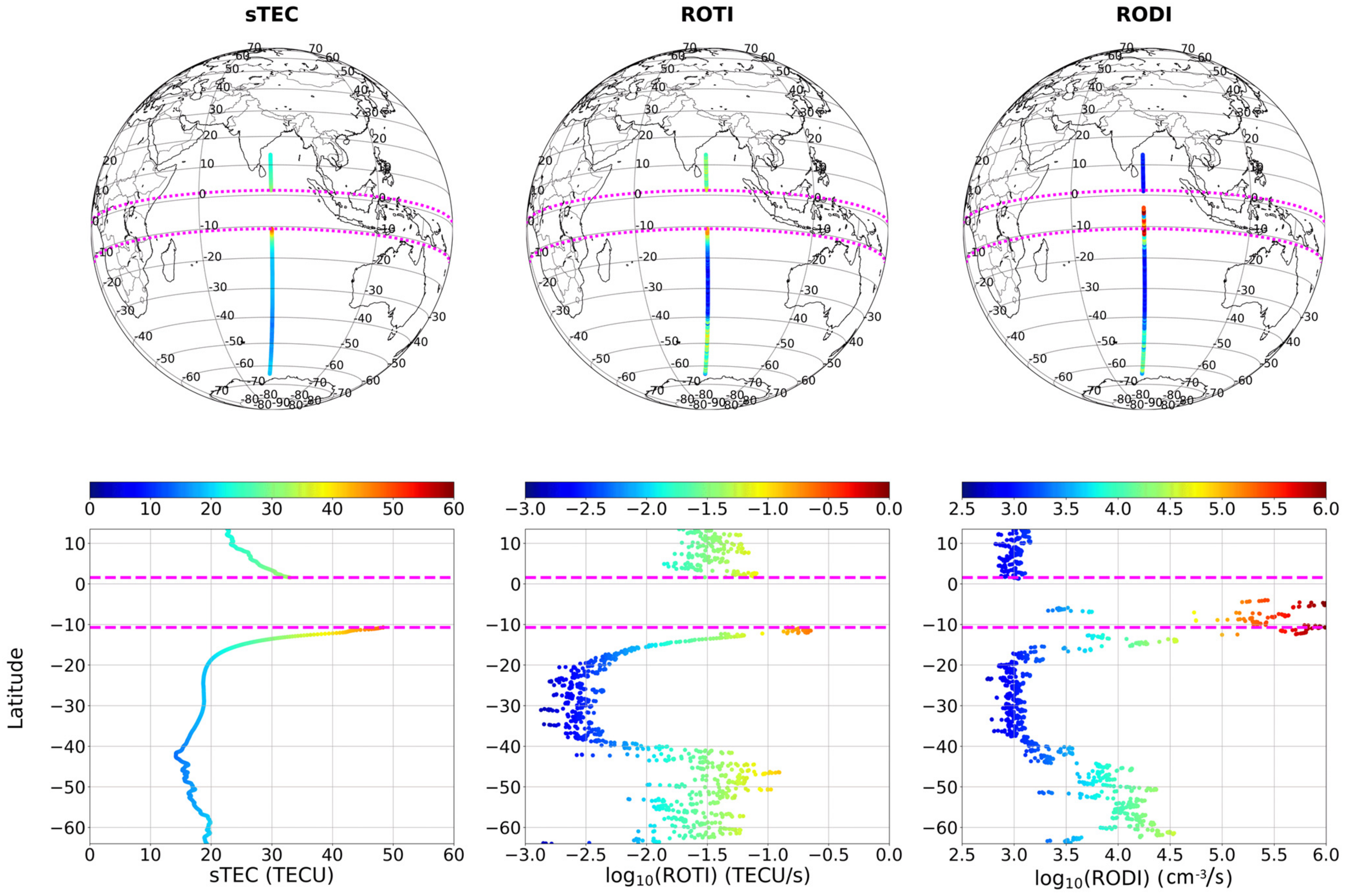
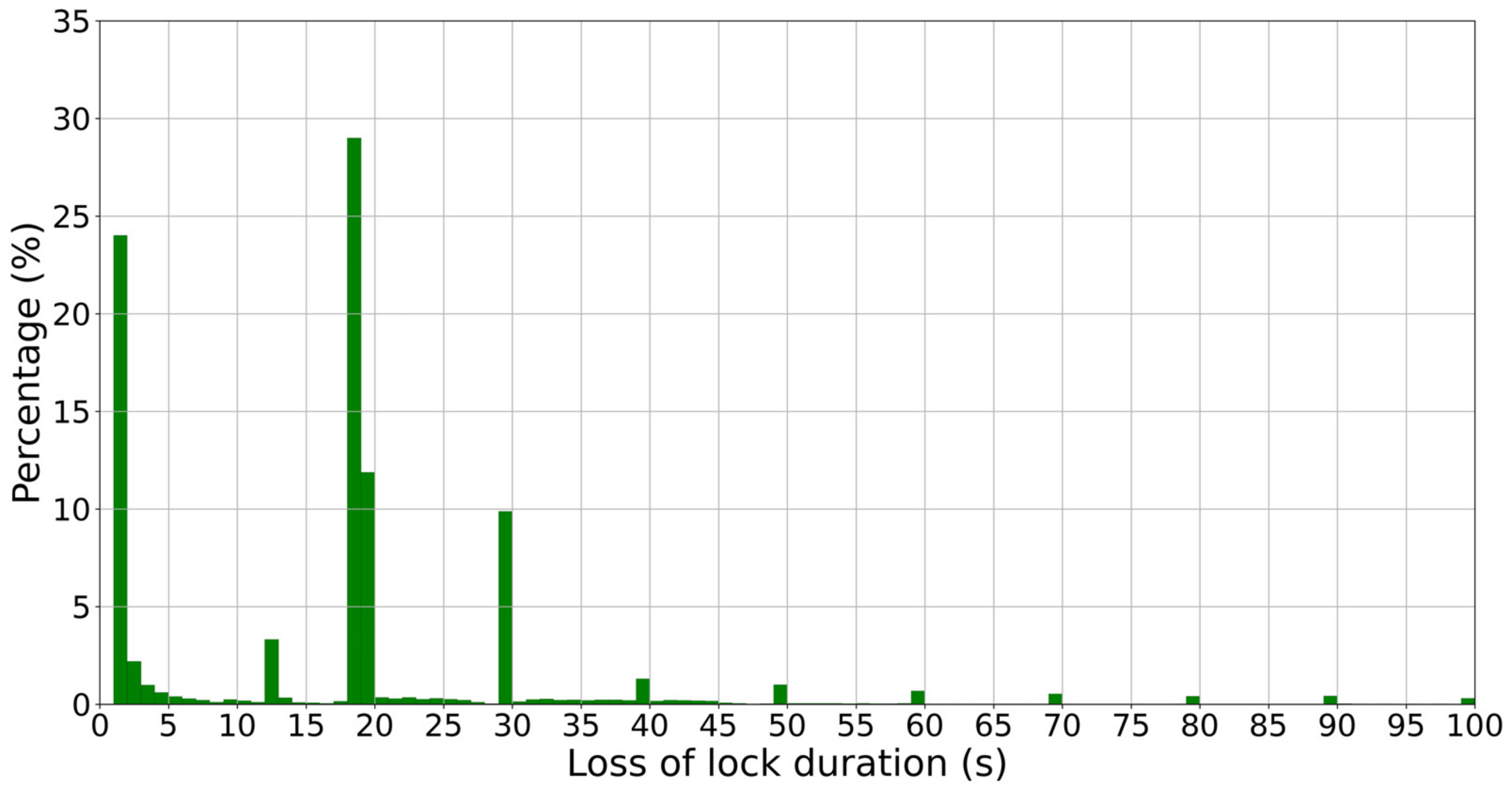
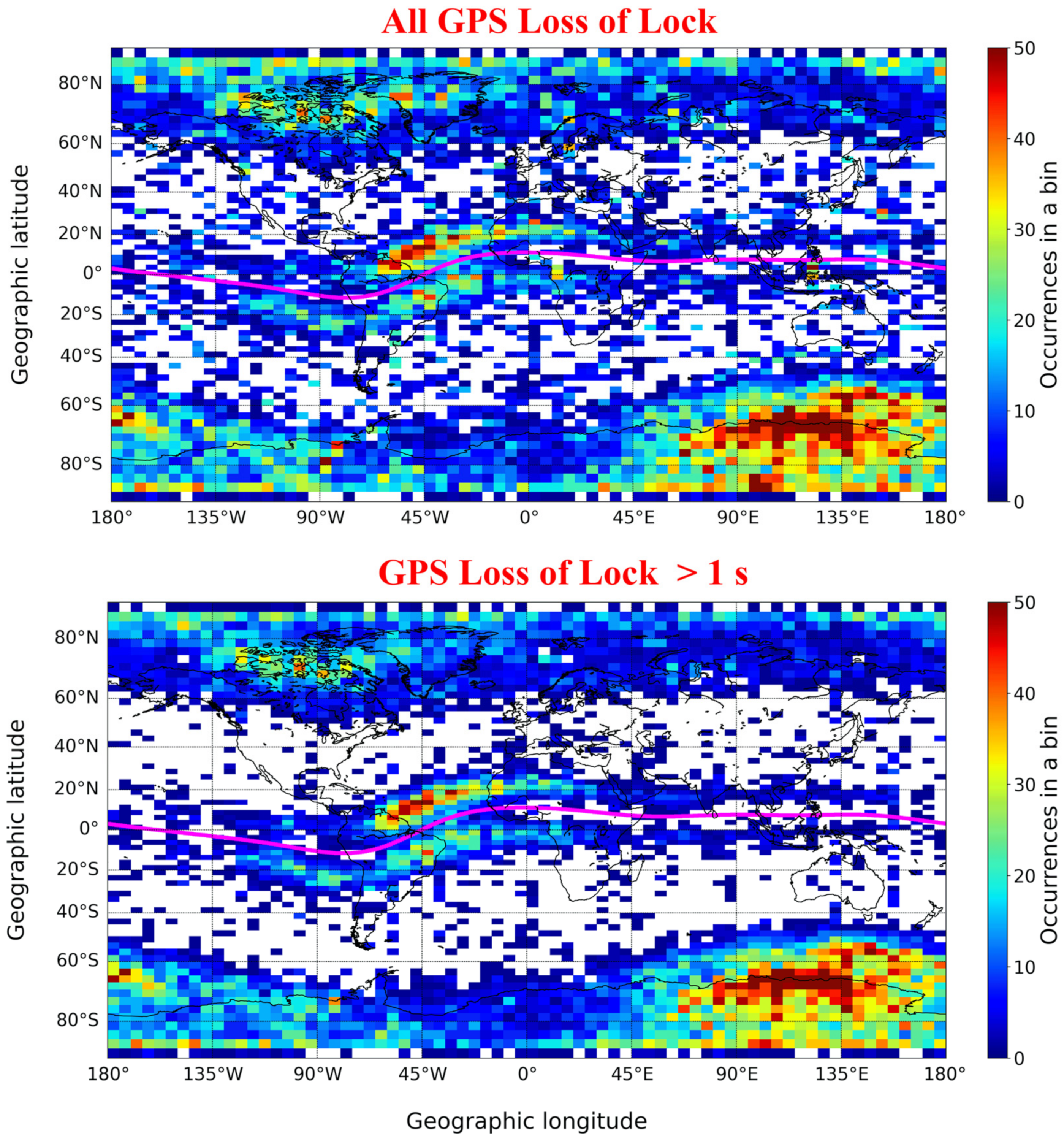
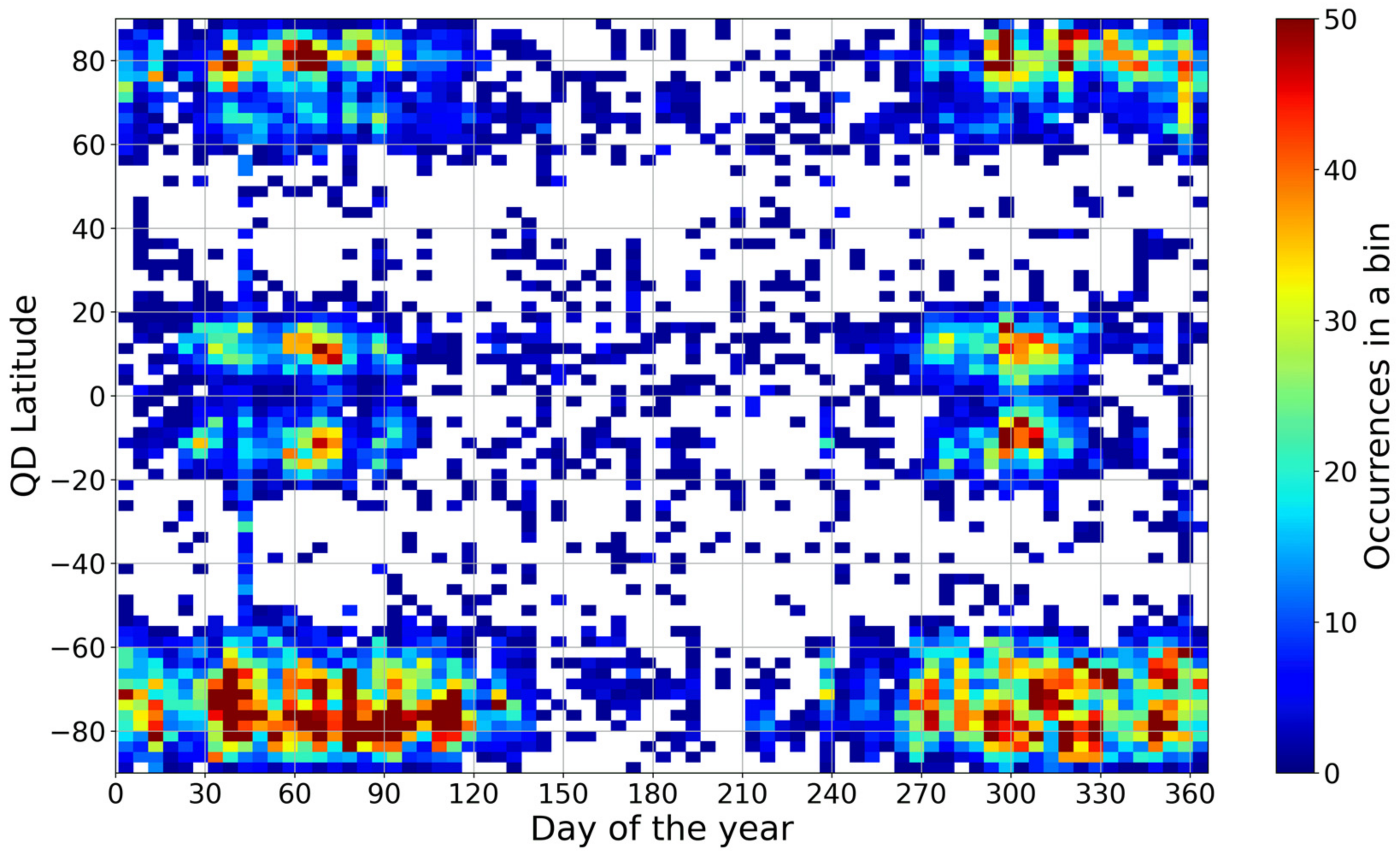
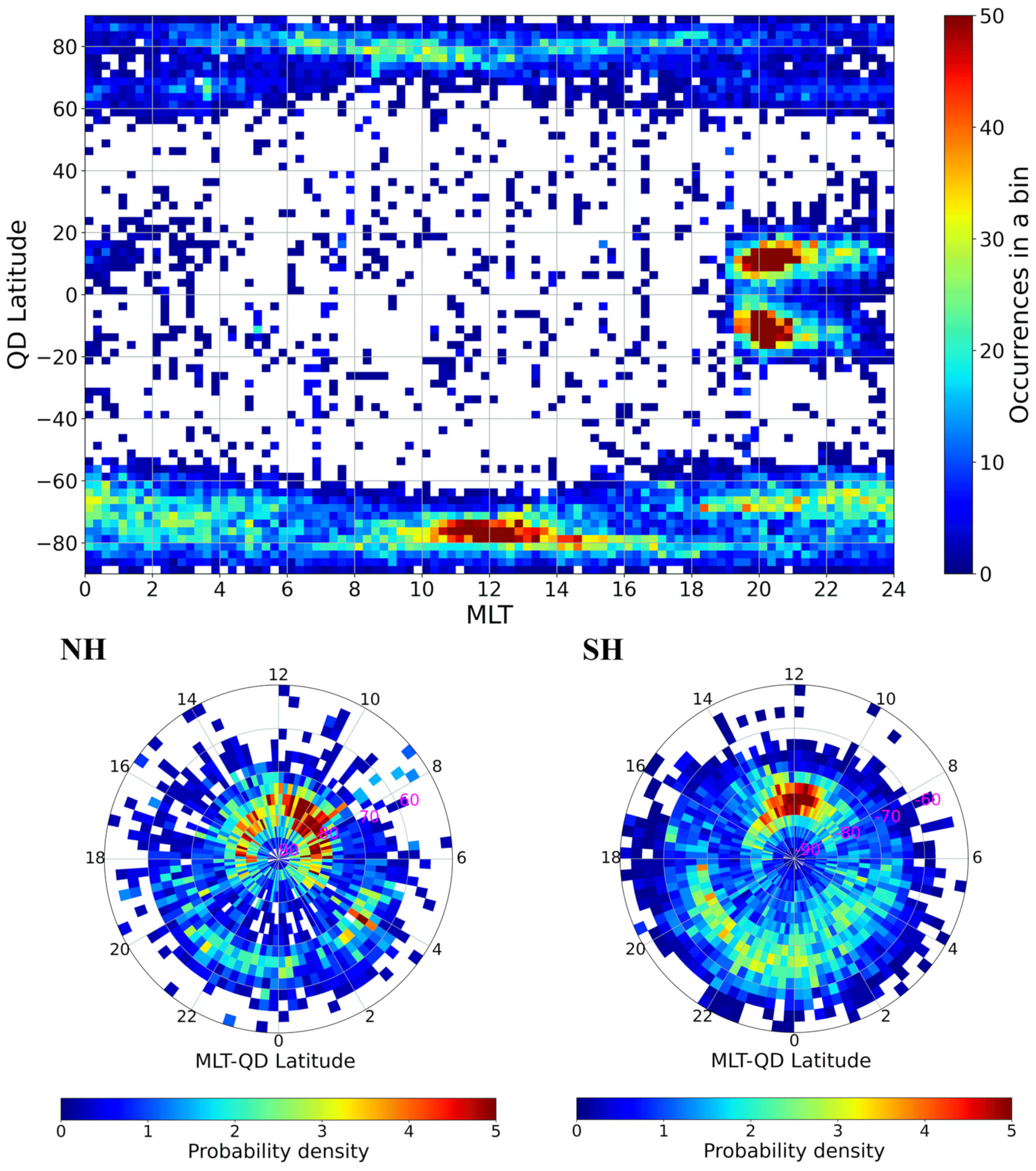

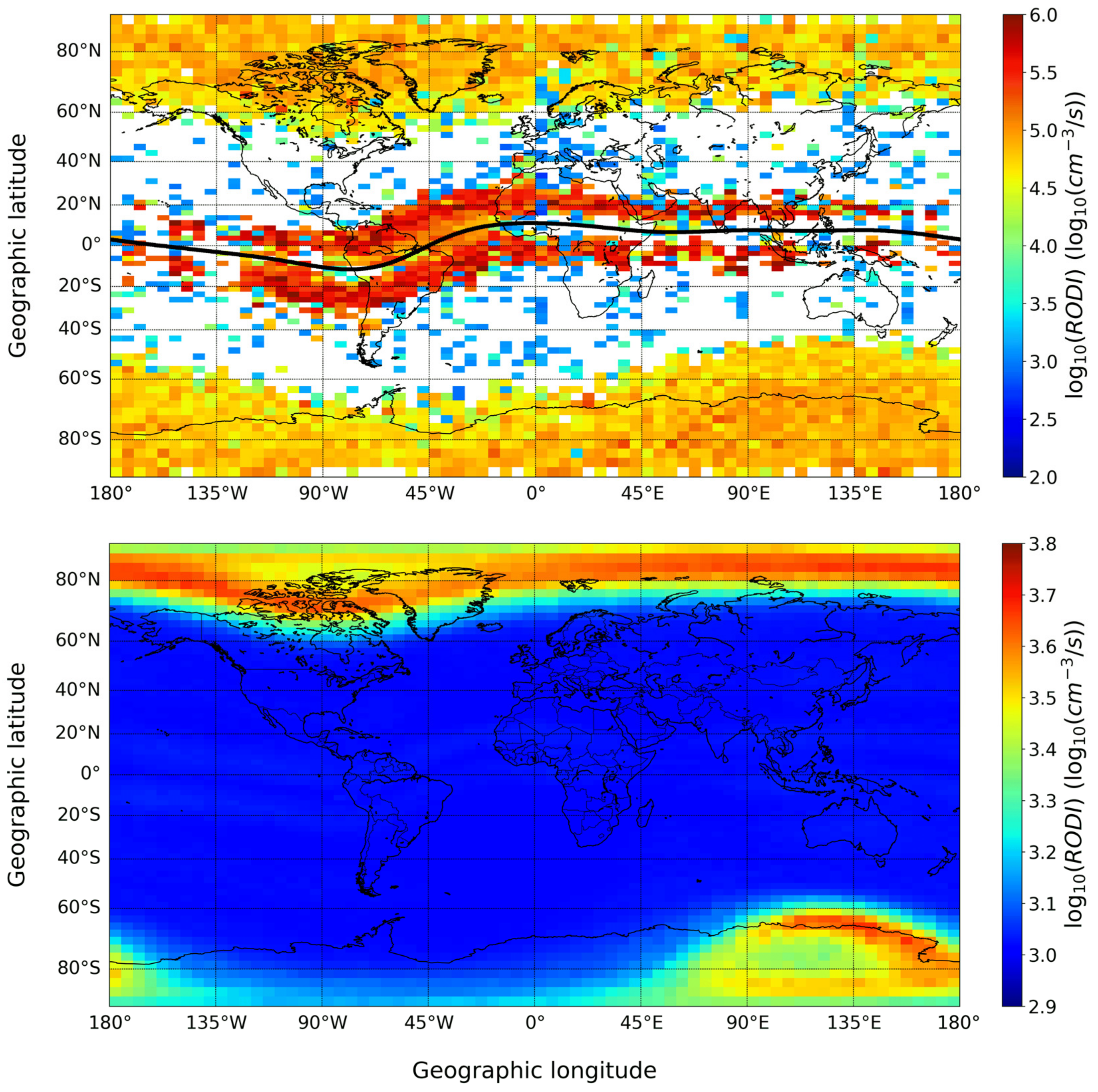
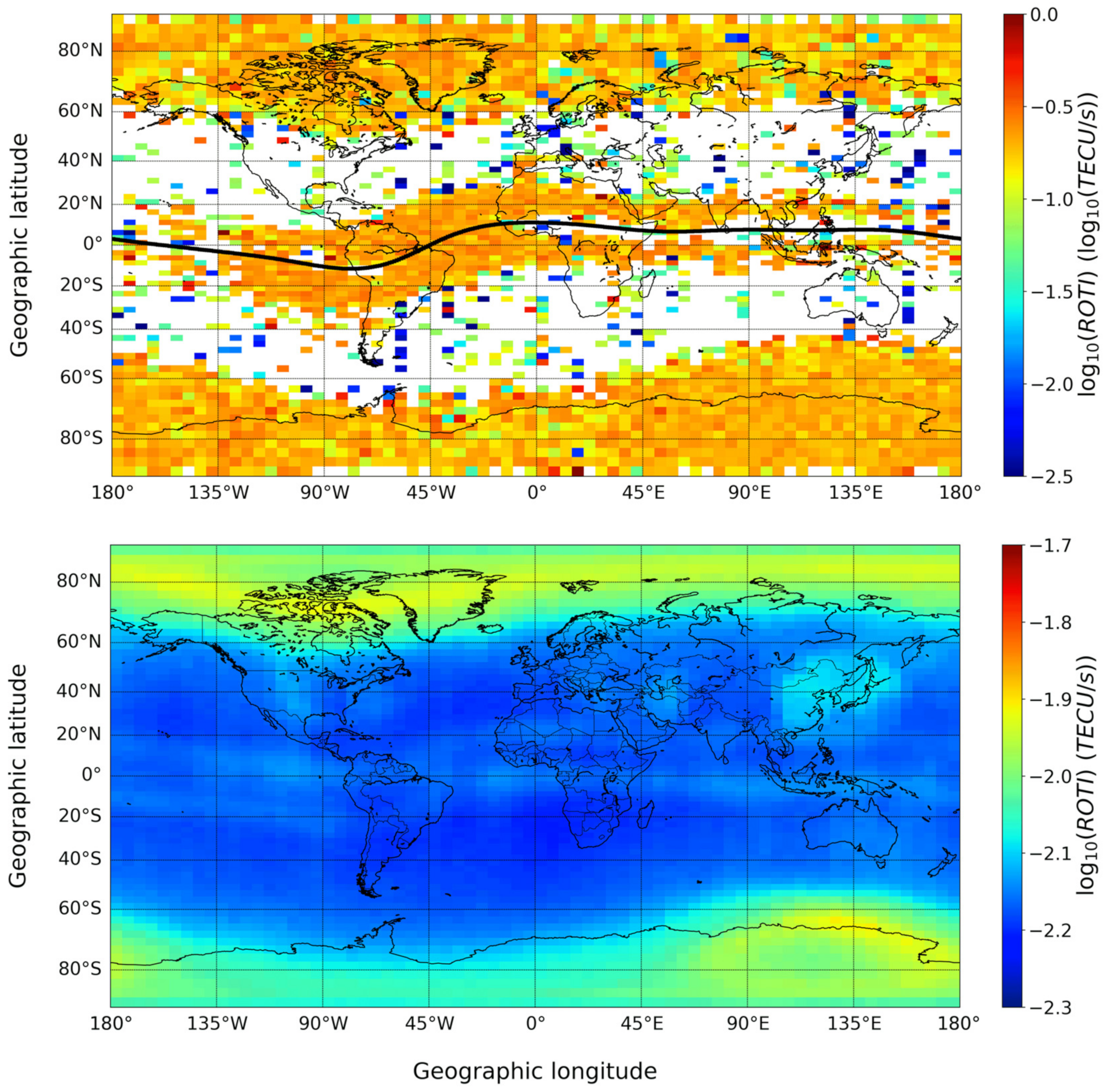
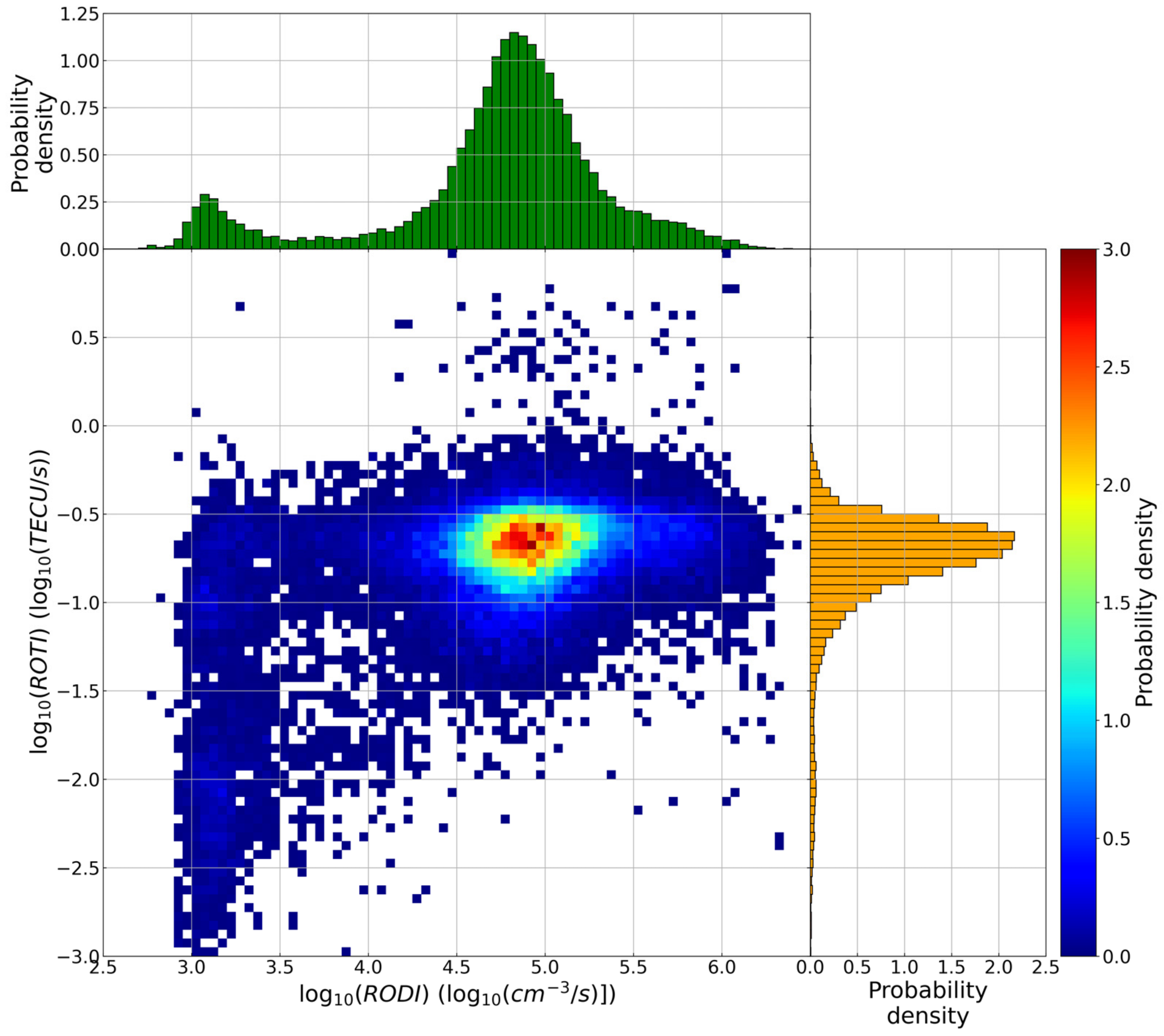
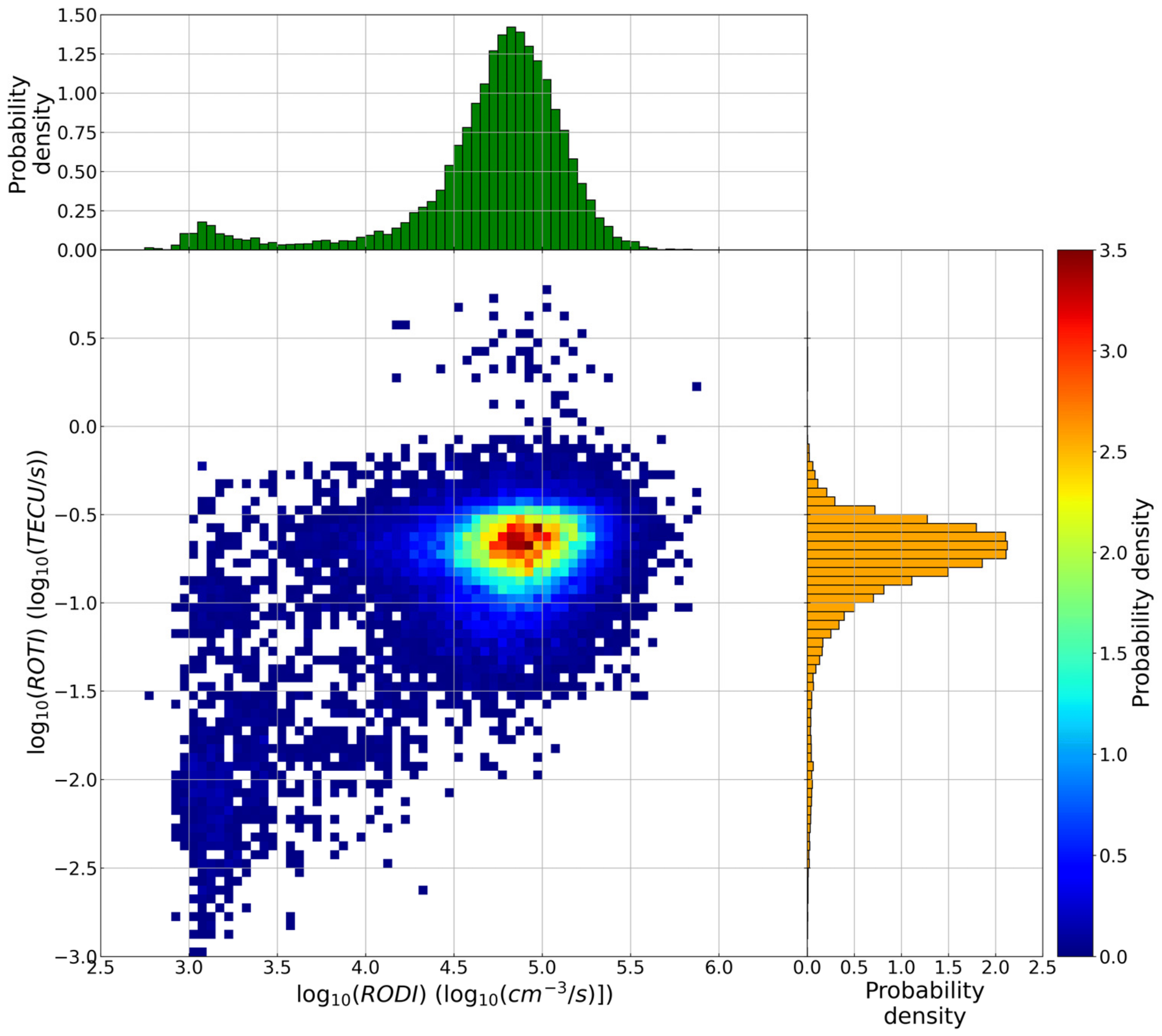
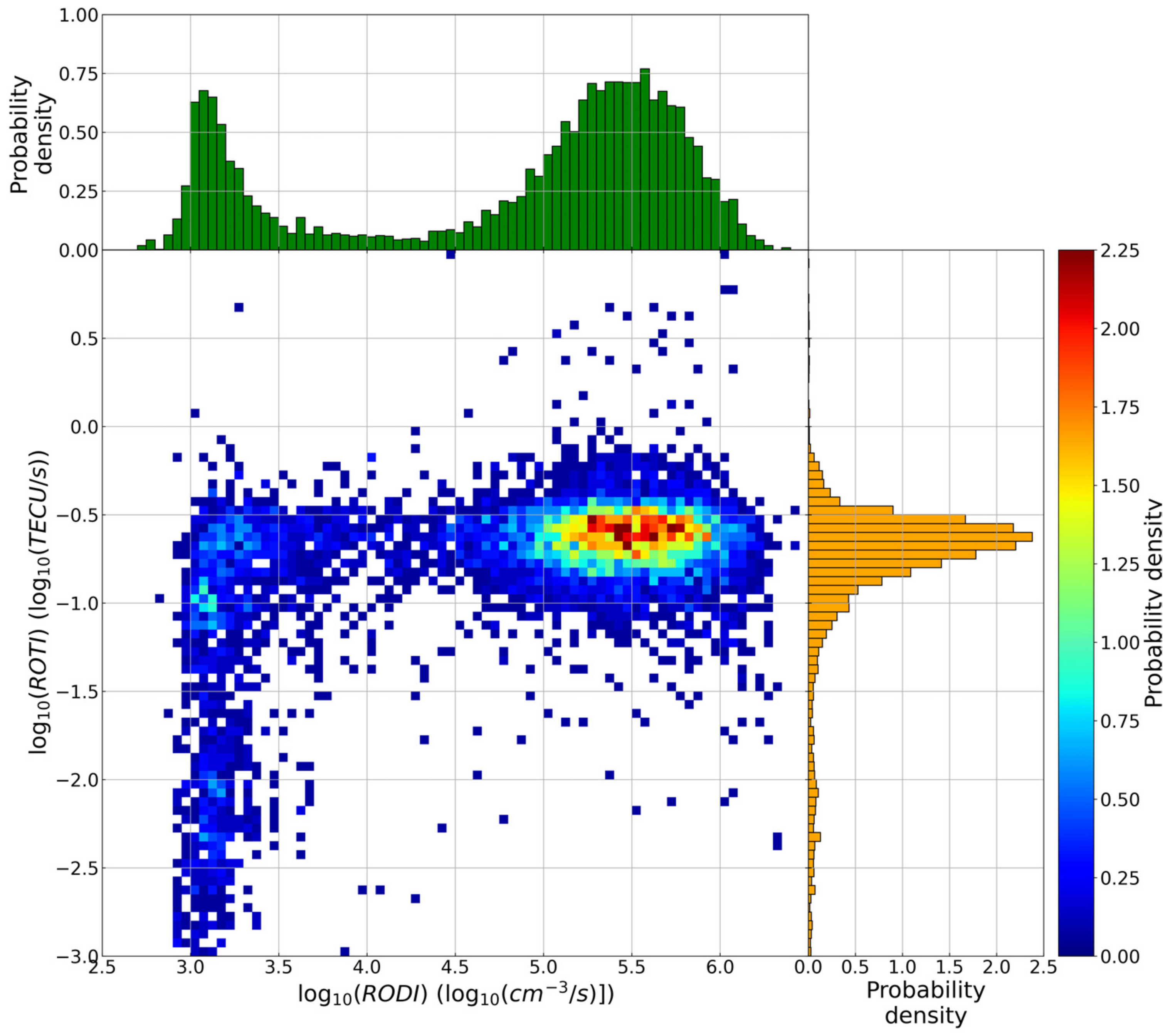
Publisher’s Note: MDPI stays neutral with regard to jurisdictional claims in published maps and institutional affiliations. |
© 2021 by the authors. Licensee MDPI, Basel, Switzerland. This article is an open access article distributed under the terms and conditions of the Creative Commons Attribution (CC BY) license (https://creativecommons.org/licenses/by/4.0/).
Share and Cite
Pezzopane, M.; Pignalberi, A.; Coco, I.; Consolini, G.; De Michelis, P.; Giannattasio, F.; Marcucci, M.F.; Tozzi, R. Occurrence of GPS Loss of Lock Based on a Swarm Half-Solar Cycle Dataset and Its Relation to the Background Ionosphere. Remote Sens. 2021, 13, 2209. https://doi.org/10.3390/rs13112209
Pezzopane M, Pignalberi A, Coco I, Consolini G, De Michelis P, Giannattasio F, Marcucci MF, Tozzi R. Occurrence of GPS Loss of Lock Based on a Swarm Half-Solar Cycle Dataset and Its Relation to the Background Ionosphere. Remote Sensing. 2021; 13(11):2209. https://doi.org/10.3390/rs13112209
Chicago/Turabian StylePezzopane, Michael, Alessio Pignalberi, Igino Coco, Giuseppe Consolini, Paola De Michelis, Fabio Giannattasio, Maria Federica Marcucci, and Roberta Tozzi. 2021. "Occurrence of GPS Loss of Lock Based on a Swarm Half-Solar Cycle Dataset and Its Relation to the Background Ionosphere" Remote Sensing 13, no. 11: 2209. https://doi.org/10.3390/rs13112209
APA StylePezzopane, M., Pignalberi, A., Coco, I., Consolini, G., De Michelis, P., Giannattasio, F., Marcucci, M. F., & Tozzi, R. (2021). Occurrence of GPS Loss of Lock Based on a Swarm Half-Solar Cycle Dataset and Its Relation to the Background Ionosphere. Remote Sensing, 13(11), 2209. https://doi.org/10.3390/rs13112209







